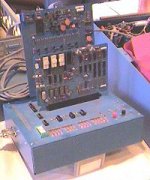Dwight Elvey
Veteran Member
I'm posting this to maybe stir up some interest in the I4004. This is some code I wrote for my MCS-4 setup. It is complete with the SIM4-01 and MP7 1702A programmer. Normally I use it to read and/or program 1702As. I wrote this program to speed up the programming of multiple EPROMs. Because the normal code that is used with this setup is normally fed from a paper tape at 110 baud and in BNPF format, it takes 7 minutes to program a 1702A. The data sheet says you can program a 1702A in 2 minutes. The extra 5 minutes is used to down load the data at 110 baud. When programming multiple EPROMs with the same code, it would be great to copy them and do it in the 2 minutes.
This is 4004 code to do just that. It is not in standard Intel format but if you know 4004 code, I'm sure you can figure it out. It is an assembler I wrote for the 4004. I is a single pass assembler so forward references are a little different. Other than that and the fact that the instruction in in RPN, it should still be readable.
The file is a Forth source but I've changed the extension to .txt from .f so that it can be posted here ( also easier to view ).
If you have a I4004 program that you've written, either for a 4004 machine you have or one of the simulators, you might post it here. That is the intend of my posting it here.
Even if your not going to post a 4004 program you might have fun trying to understand the peculiar 4004 instructions. Bitsavers has a number of resources to look at for the 4004 instruction set.
Dwight
View attachment ONECOPY.txt
This is 4004 code to do just that. It is not in standard Intel format but if you know 4004 code, I'm sure you can figure it out. It is an assembler I wrote for the 4004. I is a single pass assembler so forward references are a little different. Other than that and the fact that the instruction in in RPN, it should still be readable.
The file is a Forth source but I've changed the extension to .txt from .f so that it can be posted here ( also easier to view ).
If you have a I4004 program that you've written, either for a 4004 machine you have or one of the simulators, you might post it here. That is the intend of my posting it here.
Even if your not going to post a 4004 program you might have fun trying to understand the peculiar 4004 instructions. Bitsavers has a number of resources to look at for the 4004 instruction set.
Dwight
View attachment ONECOPY.txt



